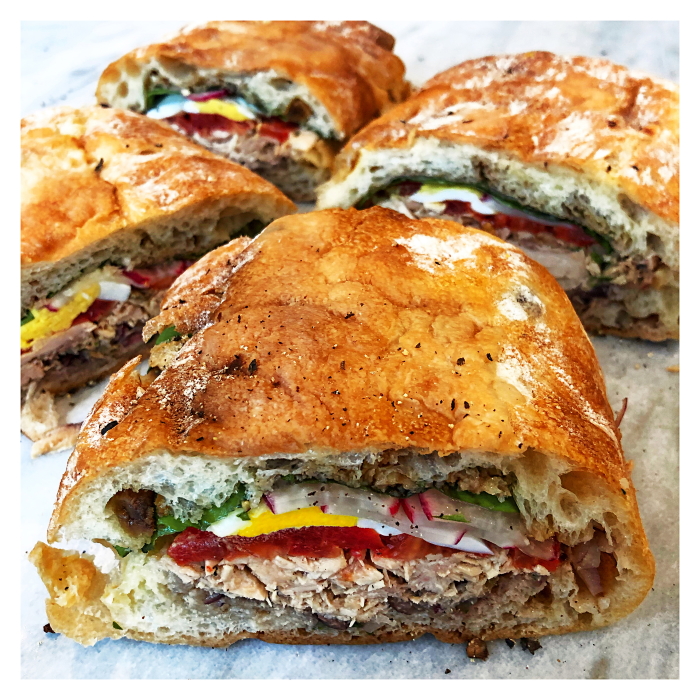By Joe Dizney
There’s something so simple about high summer eating. And it’s no wonder that we use the term alfresco (“fresh”) to describe dining outdoors — the big, bright flavors of the season are best prepared and consumed en plein air. When life is proceeding at such an unhurried momentum, life should be a picnic.
This easygoing approach to living and eating reached its zenith in the Mediterranean, and its epicenter can almost be pinpointed in Nice, on the French Riviera. Nestled in that sweet spot between Spain and Italy directly across the sea from Morocco, northern Africa and the Levant, it’s where these cultures of the sun converge. Nice enjoys a climate that allows the cultivation of just about anything; the cuisine is a celebration of the height of summer markets — from farmers’ to fishermen’s — soaked in fruity olive oil and pungent with garlic and fresh herbs.
Ratatouille, pissaladière, salade Niçoise — the names are as evocative of their preparation and flavors as they are of the pure joy and carefree, sun-drenched style of eating, living and being.

Salade Niçoise exemplifies the sensibility: oil-cured anchovies, tuna and olives, onions, capers, tomatoes, radishes, a hard-cooked egg, greens, perhaps a boiled potato or handful of crisp green beans — this is the quintessentially informal, all-in-one meal on a plate.
Better still is the pan bagnat, or pan bagna (pronounced “‘pan ban-yah”), a particularly Nissartian sandwich and common street food. Pan bagnat is basically a salade Niçoise between bread. The name means “bathed bread,” and when properly prepared is a juicy, sloppy mess.
A crusty loaf, scooped clean of excess crumb, becomes the delivery device for an overabundance of Provençal ingredients. The whole is saturated in the same garlicky vinaigrette that dresses the individual parts, summarily compressed and transformed into something extraordinary.
Light but substantial, pan bagnat also travels well. It’s a great choice for picnics, seaside or mountaintop, and requires only beverages and napkins. Lunch for a crowd can be easily assembled the night before.
Kitchen caveats: Since most of the “innards” of the bread get tossed, and what’s left is “tenderized” by the dressing, the bagnat was likely a means to utilize day-old bread. But it pays to start with good materials: the Niçoise bagnat calls for a classic white baguette or country wheat cannonball or boule. I personally prefer a broad, crusty ciabatta; while maybe not strictly authentic, it works just fine.
As most of the other raw materials are fresh (tomatoes, radishes, eggs) and salt- or oil-cured (anchovies, olives, capers), aim for quality, particularly as regards the tuna, olive oil and balsamic. Lots of fresh basil completes the formula, although food writer and Nice native Mireille Johnston suggests fresh mint.
Above all, don’t overcomplicate it or get too precious. It’s about keeping things nice and easy.
Pan Bagnat
Makes about four portions
1 unsliced baguette or ciabatta (about 12 to 14 inches long); or a rustic boule, 7 to 8 inches in diameter
3 tablespoons Balsamic vinegar
2 tablespoons fresh lemon juice
2 cloves garlic, finely grated
½ cup minced shallots (or red onion)
¾ cup extra-virgin olive oil
1 tablespoon Dijon mustard
Freshly ground black pepper to taste
4 to 6 olive oil- or salt-packed anchovies, drained or rinsed; mashed
2 tablespoons flat leaf parsley, chopped
½ cup pitted Niçoise (or Kalamata) olives, roughly chopped
2 to 3 tablespoons brined or salt-packed capers, rinsed and drained
6 ounces (olive) oil-packed tuna, drained lightly
2 plum tomatoes, sliced, reserved
4 radishes, thinly sliced, reserved
2 hard-cooked eggs, sliced, reserved
18 to 20 large basil leaves
- In a small bowl, whisk together the lemon juice, vinegar, garlic, shallots (or red onion), anchovies, olive oil and mustard; stir in parsley, season to taste with salt and pepper and reserve.
- Place olives and capers in a small bowl. Add 2 to 4 tablespoons dressing and toss lightly to coat. In another small bowl, toss tuna with 2 to 4 tablespoons of dressing.
- Slice bread in half lengthwise. Roughly remove excess soft interior of the loaf to leave about a ¾- to 1-inch shell. Spoon and spread enough of the dressing on each of the cut sides of the loaf to moisten. On the bottom half, layer on the onion-olive mixture. Layer on the tuna with a drizzle of any leftover dressing from the olives or tuna. Layer first the tomatoes, then the sliced eggs, followed by the radishes. Drizzle more dressing over all and top generously with basil leaves.
- Place the top half of the loaf over the filled bottom and wrap tightly with plastic wrap. On a half-sheet pan or large plate, weigh the whole down with another pan topped with enough weight to compress the whole (or use a cast-iron skillet). Refrigerate for at least two hours, up to overnight, turning occasionally. To serve, cut into quarters and allow to rest a bit at room temperature.

Yum!